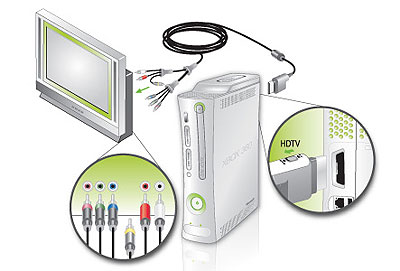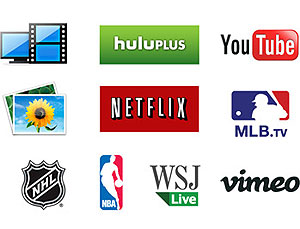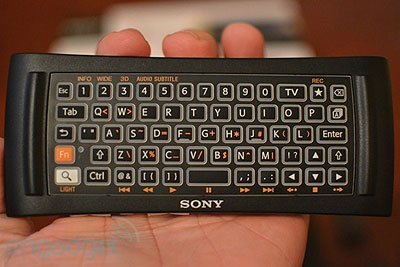TV Is Dead, Long Live TV: November 16, 2012 – A Guide To Cutting The Cord
Published on November 16th, 2012 in: Science and Technology, Streaming, The Internets, TV, TV Is Dead Long Live TV |The latest in our ongoing series on the life and death of linear television, a.k.a. old-style appointment television, TV that only moves forward in time. For previous installments, go here.
This installment will outline your best options for cutting the cord to your cable or satellite subscription.

Ed White, the first American Spacewalker, was attached to Gemini IV
by both a 25 foot umbilical line and a 23 foot tether. If he was one of the eight million people watching Felix Baumgartner let free his cords
and drop to earth last month, he likely did so via a live feed from YouTube. Photo © 1965 Johnson Space Center
The holidays are coming, and so are big sales on electronics. If you’ve been thinking about getting rid of your cable bill and switching to Internet TV, generally the best time to pick up a device is just before or after the holidays. There are over a dozen ways to cut the cord, but below I’ve broken down the three most popular options for those living in the United States:
Option I: A gaming platform such as the Xbox 360.
Option II: A TV app device such as Roku or Apple TV.
Option III: An Internet connected television like those marketed by Google.
This article will discuss the merits and drawbacks of all three, as well as touch on some of the other bits and pieces you’ll need after ditching cable. Before you start deciding on a device, I encourage you to sit down and ask yourself the following questions:
A) What television is really important to me? What shows could I not live without?
B) In how many rooms do I want to watch television? Can I alter my habits to match the room where television is viewed?
The answers to questions A and B will be important in determining your choice of device. We’ll now go through options I, II, and III and lay out the major pros and cons of each, followed by a formula for calculating your costs.
Option I: A gaming platform such as the Xbox 360.
For a few years now Microsoft’s Xbox has offered game players the ability to stream Netflix, Hulu, and some other forms of content. However, the new Xbox 360 was called “a true cable box killer” by Matt Burns at Techcrunch. Microsoft had noticed how much their gaming fans enjoyed streaming video over their device, and with its new iteration expanded its apps and channels to compete with the Roku box. For those with kids, the Xbox 360 is perfect for the playroom—a machine that plays games, movies, and offers up the great children’s content on Netflix. I plan on getting one for my kids next year when they are seven and five, and my husband and I launch what we’re calling “project game room.” A feature that puts the Xbox 360 ahead of the Roku box in television content is the ability to access YouTube.
A primary complaint regarding the Xbox 360 is that users have to pay $5 per month in order to use the device to get television content. That’s $60 per year, plus what you pay to get Internet service to your home, and your membership fees to Netflix and Hulu Plus. With the retail price of Xbox 360 running around $200, another $60 per year seems a bit greedy, but at the same time Microsoft is also selling access to its fairly reliable network.
You’ll note that I described this option by saying “a gaming platform such as the Xbox360,” but then only discussed one machine. That’s because in this area Xbox is far out in front of its competitors. If you choose this option for cord cutting, do take a look at the other machines, but know they’re all stacking up against Microsoft’s considerable offerings.
Cost for option I: $200 for the device, your monthly Internet bill, $5 monthly for Xbox Gold service, price of subscription services to Netflix ($8 monthly), Hulu ($8 monthly), and others as needed.

That’s a lot of jacks they have going on in the back there.
With this device and others, you’re going to need an HDTV cord to get a good picture.
Option II: A TV app device such as Roku or Apple TV.
There are lots of TV app devices, but I’m only going to discuss the two most popular here, Roku and Apple TV. The Roku box has a large word-of-mouth fandom for a reason; this box came on to the market in 2008 and rapidly made its name as the affordable cord cutting option. Retailing between $50 and $100, Roku offers a variety of small devices that users can quickly connect to any television, turning it into an instant app store for Netflix and hundreds of other television watching options. While the Roku box may have problems buffering content offered by Hulu Plus, this can be corrected with the addition of a memory chip. Roku also just rolled out a Universal Search Feature that allows users to search across channels—so that finding a movie doesn’t involve not finding it on Netflix, and then not finding it on Crackle, and then hopefully finding it on Amazon’s channel. For federated search engine fans like myself, it’s a fabulously nerdy and awesome capability.
The chief drawback to the Roku box is the inability to watch YouTube with the device. Around eight million people were able to simultaneously watch Felix Baumgartner make his historic jump from space. The feed of this event was not provided to networks, so YouTube was the only place to watch a live stream of Baumgartner’s amazing fall. While Xbox 360 has a YouTube channel, Roku remains outside the Google loop, as Google TV sees Roku as a direct competitor. How Microsoft gained access and Roku remains locked out of YouTube is a great question, but like all things, it probably comes down to cash. I’m guessing that some of the $5 monthly Xbox access fee gets kicked back in some way to those running YouTube.
Apple TV is a similar device to Roku, and Matthew Moskovciak at CNET wrote a great comparison of the two devices. Apple TV’s main selling point is that it integrates seamlessly with other Mac products you may have at home. If the majority of your TV comes in the form of iTunes subscriptions to first-run shows, Apple TV is the best way to get current broadcasts on the screen the day after they’re broadcast. Both Apple and Roku are easy to connect and use, and are dependable delivery systems for Internet television content.
Cost for option II: Both Apple and Roku cost around $100; add to this your monthly Internet bill and price of subscription services to Netflix ($8 monthly), Hulu ($8 monthly), and others as needed. If you plan on going with Apple TV because of your iTunes subscriptions, be sure to add in the cost of those as well.

Some selections available on Apple TV. Note the lack of NFL programming, which is tied up in contracts with ESPN/Disney.
See the Other Considerations section of this article for notes on ESPN and HBO content.
Option III: An Internet-connected television like those marketed by Google.
There are lots of smart televisions on the market now, and it can all be very confusing. If you’re considering purchasing a new television, I highly recommend investing in the Consumer Reports electronic buying guide. Twelve dollars spent on the buying guide might prevent a really regretful decision in this area. Worth mentioning here is that any smart TV—new or old—can use the Roku streaming stick to turn itself on to Option II above. If you find a slightly used smart TV being sold at a low price by someone upgrading to the newest thing, that plus a $50 Roku stick might get you what you want to watch.
The big fish in Internet connected televisions is Google TV, and there are several different ways to hook into the Google TV application. Both Vizio and Sony make Google TV boxes for around $200. Some televisions sold by both makers come with these boxes in bundles with the new product.
I was unimpressed by the first generation of Google TV offerings, but the second generation has been getting solid reviews. Of further interest to many is the actual keyboard one can use with Google TV, something the other options here lack. Said my friend John, who loves his Google TV: “I don’t care about anything but Netflix and YouTube. And I hate the Roku remote—I want a keyboard.”
So, if you’re like John, Google TV is for you. He has a point—and that live stream of the space jump would have been nice to watch on a quality television screen. Fans of Google will be quick to point out there are integrations with the Android app store as well. The limited content will annoy those who want to play with the new diversity offered by Internet television, but if your primary forms of entertainment are Netflix and YouTube, Google TV is the device you want and need.
Cost for option III: $200 for the device, add to this your monthly Internet bill and price of subscription services to Netflix ($8 monthly). You won’t be watching much more than Netflix and YouTube on this, so at least there won’t be the temptation to overspend on other television aps. With the weight of Google’s developers behind this option, many have high hopes for future content offerings.

Other Considerations
When cutting the cord, you should also take into account include your willingness and ability to disconnect from HBO and ESPN. While both offer channels to options I and II, these are only watchable if you still have a cable subscription—meaning that you’ll be paying around $100 per month just to see HBO and/or ESPN content. Personally, I am annoyed every time I see an HBO Go ad on my Roku. I bought a Roku to get rid of cable—why would I subscribe to cable just to get content on my Roku? I’m not the only one with this question, and it is the devout hope of many a sports fan that ESPN and HBO offer stand-alone options for their content soon. Cable channels need to understand that winter isn’t coming; it’s already here. I’d gladly pay around $20 per month to watch HBO without inviting 80 other channels I don’t want into my home.
There are other, simpler options as well. My friends Heather and Cindy opted years ago just to plug a laptop into their television and are still happy with that decision. Sure, they lack a remote and the quality leaves something to be desired, but they aren’t bothered by this at all. Seamlessly shifting from watching fan vids on YouTube to classic Dr. Who on Netflix, they are the new reality of fandom controlling their own television programming. They have no regular watching schedule, and try new programming based on word-of-mouth, showings at conventions, and previews on blogs. They rarely see commercials. They run show marathons, taking in entire seasons of shows in blocks as they become available on DVD or Netflix.
At the end of the day, how you chose to watch television will depend on your viewing preferences, budget, and connection to your favorite types of programming. The options for cutting the cord will only continue to multiply and improve over time.
I have to watch how-to videos on my laptop, because my house is currently using Option II. When my family exercises Option I, the kids will have to give up their game time when mommy needs to watch tutorials.
Time limit is exhausted. Please reload the CAPTCHA.